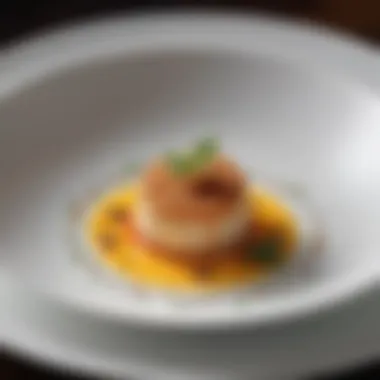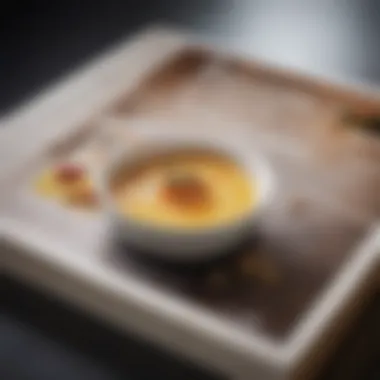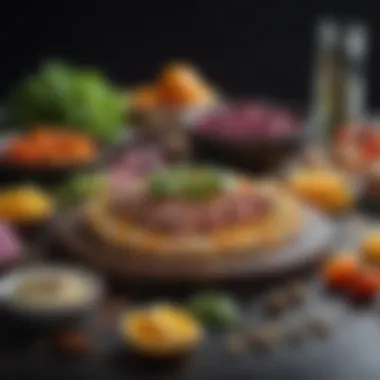The Michelin Star Cookbook: Culinary Excellence


Intro
The Michelin star represents not only prestige in the culinary world but also a relentless pursuit of perfection. Understanding this system is essential for anyone fascinated by gourmet cooking. This article serves as a guide to Michelin star cookbooks, shedding light on their importance and the meticulous craft behind each recipe.
Each cookbook selected for examination has its own story, showcasing the craftsmanship and creativity of its authors. We explore key ingredients, innovative techniques, and the cultural significance behind Michelin dining. By delving deeper, we aim to reveal the journey from high-end restaurants to one’s own kitchen, empowering home cooks to incorporate these skills into their culinary practices.
By gaining insight into these cookbooks, as well as the chefs who created them, readers can elevate their appreciation for the art of cooking. Whether you are a seasoned chef or a novice looking to enhance your repertoire, this exploration will provide valuable knowledge and practical advice.
The structure of this article is designed to inform and inspire. We will discuss the essential principles that characterize Michelin-starred cuisine, review notable cookbooks, and offer actionable steps for integrating advanced techniques into everyday cooking.
Understanding Michelin Star Ratings
Understanding Michelin Star Ratings is crucial for both culinary professionals and food enthusiasts. This rating system, established by the Michelin Guide, serves as a benchmark for restaurant excellence across the globe. It offers diners insight into the quality of culinary experiences they can expect. The significance of these ratings cannot be underestimated, as they influence dining decisions and the success of restaurants.
Origins of the Michelin Guide
The Michelin Guide was first published in 1900 by the French tire company Michelin. Originally intended to encourage road travel and thus boost tire sales, the guide provided essential information for motorists, such as maps, eateries, and accommodations.
The introduction of restaurant ratings occurred in 1926, when stars were first awarded to fine dining establishments. Over time, the Michelin Guide evolved into a prestigious authority in the culinary world, especially in Europe and, later, globally. Today, it is synonymous with the highest cooking standards, embodying prestige that chefs aspire to achieve.
Criteria for Michelin Star Awards
The Michelin Guide employs a set of rigorous criteria when assessing restaurants and awarding stars. There are three levels of recognition:
- One Star: A very good restaurant in its category.
- Two Stars: Excellent cooking, worth a detour.
- Three Stars: Exceptional cuisine, worth a special journey.
Factors evaluated include the quality of ingredients, mastery of techniques, harmony of flavors, and consistency over time. It's not merely about the food; service, ambiance, and overall experience also play a role in the awarding of stars. These criteria help maintain high expectations from both chefs and diners, fostering an atmosphere of continuous improvement.
Significance of Michelin Stars in the Culinary World
Michelin stars hold considerable influence over the culinary landscape. For chefs, receiving a star can be a career-defining moment, providing recognition beyond their local area. Chefs often find that achieving or maintaining a star can lead to increased reservations, higher menu prices, and elevated career opportunities.
For patrons, a Michelin star is often a guarantee of high-quality dining experience, which can be especially appealing for special occasions. The Michelin Guide not only guides diners but also impacts trends in the culinary arts, as chefs strive for innovation while adhering to the standards expected of a Michelin-starred establishment.
"Michelin stars are the benchmarks of culinary excellence, guiding both chefs in their craft and diners in their quest for unforgettable meals."
Understanding the significance of Michelin star ratings enhances appreciation for fine dining and directs attention to the craftsmanship involved in Michelin-starred cookbooks, aiming to share these culinary insights with a broader audience.
A Closer Look at Michelin Star Cookbooks
Michelin star cookbooks serve as a vital connection between the art of high-end culinary practices and the kitchens of aspiring chefs and home cooks. This section aims to uncover the layers that make these cookbooks more than just collections of recipes. Each book reflects a chef's philosophy, their approach to sourcing ingredients, and their dedication to presenting culinary excellence.
The importance of Michelin star cookbooks lies not only in their recipes but also in their ability to inspire. They present a unique blend of technical know-how and creative expression. Readers who engage with these books do more than learn to cook; they gain insights into the meticulous process that defines gourmet cuisine.
Furthermore, these cookbooks often encapsulate the essence of a restaurant's experience, translating the ambience and ethos of Michelin-starred establishments into everyday contexts.
Defining Features of Michelin Star Cookbooks
Michelin star cookbooks have distinctive features that set them apart from traditional cookbooks. These aspects include:
- Comprehensive narratives about the culinary journey of the chef.
- Detailed techniques that guide readers through complex processes.
- A focus on seasonality and local sourcing of ingredients to maintain quality.
Unlike generic cookbooks, Michelin star volumes often delve into specialized techniques such as sous-vide or fermentation. These features not only outline the recipe but also educate the reader on why each step is critical.


The Role of Recipes in Michelin Star Cookbooks
Recipes in Michelin star cookbooks are carefully curated to exemplify precision and artistry. Each recipe is an opportunity for the reader to engage fully with the flavors and textures intended by the chef. Recipes may include detailed ingredient lists, methods, and often personal notes from the chef, providing context and enhancing the reader's understanding.
Moreover, many Michelin star cookbooks focus on tasting menus or signature dishes that encapsulate the essence of a chef’s artistry. This focus helps readers appreciate the balance of flavors and presentations that define a Michelin star-worthy dish, encouraging them to experiment in their own kitchens.
Illustrations and Photography: Enhancing the Culinary Experience
High-quality illustrations and photography are critical components of Michelin star cookbooks. They are not mere decoration but serve to:
- Visualize techniques that may be difficult to conceptualize.
- Provide inspiration through stunning representations of food.
- Illustrate the presentation that is a hallmark of high-end cooking.
Seeing a beautifully plated dish can motivate readers to strive for similar results in their own cooking. It reinforces the connection between visual appeal and culinary success, showing how presentation can elevate even the simplest of dishes.
"A dish's appearance is a silent communicator, conveying the chef's passion and understanding of food."
By understanding these elements, readers can appreciate the depth of knowledge that Michelin star cookbooks offer, transforming their approach to cooking into an endeavor that is both artistic and precise.
Notable Michelin Star Cookbooks and Their Authors
Notable Michelin star cookbooks represent a significant intersection of culinary artistry and literature. They serve not only as practical guides for cooking enthusiasts but also as testimonies of the innovative spirit of some of the world's most acclaimed chefs. These cookbooks compile timeless techniques, signature recipes, and personal stories, contributing to a rich tapestry of culinary history. The importance of these works lies in their ability to inspire and educate both aspiring chefs and home cooks alike. By engaging with these texts, readers gain insight into the philosophy and practice of cooking at the highest level.
Signature Works by Renowned Chefs
Renowned chefs, with their unique perspectives and experiences, have authored various cookbooks that have become essential references in gourmet cooking. These books offer more than just a collection of recipes; they provide a lens into the chefs' culinary journeys.
Notable examples include:
- Thomas Keller’s "The French Laundry Cookbook": This work delves into the meticulous methods employed at Keller's iconic restaurant, presenting recipes that range from approachable to complex, all enriched with personal anecdotes.
- Alain Ducasse’s "Nature": Ducasse emphasizes seasonal ingredients and the harmony of flavors. This book reflects his philosophy on cooking that respects nature and tradition.
- Massimo Bottura’s "Never Trust a Skinny Italian Chef": Bottura’s cookbook merges the art of cooking with storytelling, highlighting his creative approaches while respecting Italian culinary roots.
These cookbooks not only showcase recipes but also convey the broader culinary philosophies that underpin the Michelin star standard.
Exploring Regional Influences in Cooking Literature
Regional influences play a crucial role in the discourse surrounding Michelin star cookbooks. Every star-rated chef brings their cultural background and regional specialities into their cookbooks, enriching the global culinary landscape.
Regional delicacies often become a source of inspiration for Michelin-starred chefs. For instance, Japanese cuisine’s precision and aesthetics significantly influence culinary practices worldwide. Chefs like Yoshinori Nishida showcase the meticulous balance of flavors in their cookbooks, illustrating how traditional practices can harmonize with modern presentation.
In addition, region-specific ingredients serve as a cornerstone for many recipes, pushing home cooks to explore local markets and seasonal produce. By documenting their culinary roots, chefs create a bridge between culture and cooking, inviting readers to appreciate diverse culinary identities.
"Every spoonful tells a story, and every recipe is a journey of flavors that crosses borders and brings cultures together."
Epilogue
Notable Michelin star cookbooks are invaluable resources for anyone serious about mastering culinary skills. These works not only highlight signature recipes and techniques but also reflect the diverse regional influences that shape modern cuisine. By understanding and engaging with these texts, readers can elevate their own cooking and deepen their appreciation of gourmet culinary traditions.
Techniques and Skills from Michelin Star Recipes
Michelin star recipes represent not just food, but the pinnacle of culinary art. These techniques and skills are essential for anyone aiming to elevate their cooking. They embody precision, creativity, and a deep understanding of flavors and ingredients.
Focusing on these skills helps aspiring chefs and home cooks alike to gain a better grasp of how professional kitchens operate. Here, we will analyze critical components that define this level of cooking and how they can be beneficial to both chefs and home cooks.
Essential Culinary Techniques for Aspiring Chefs
Knowledge of essential culinary techniques is foundational. This includes knife skills, cooking methods, and flavor profiles.


- Knife Skills: Proper knife techniques are crucial. They ensure safety and efficiency in the kitchen. Mastering slicing, dicing, and mincing can drastically change how ingredients are prepared and enhance the overall dish.
- Cooking Methods: Different methods like poaching, searing, and sous-vide offer varied textures and flavors. Understanding when to use each technique can provide a dish with its unique character.
- Flavors and Seasoning: Knowing how to balance flavors is vital. Savory, sweet, sour, and bitter can all play roles in a Michelin-star dish. Chefs must learn when to adjust seasoning to perfect their results.
Plate Presentation and Aesthetics
Plate presentation is more than just how food looks. It is an art form that enhances the dining experience.
- Visual Appeal: The arrangement of food can elevate a simple dish into an exquisite experience. Colors, shapes, and textures all play in the presentation that perks the diner’s interest.
- Portion Control: Michelin chefs are intentional about portion sizes. They aim for a balance that emphasizes taste and satisfaction but never overwhelms.
- Garnishing: Well-thought garnishes can complement the dish’s flavors. It also adds a touch of sophistication that can intrigue diners.
"The first bite is with the eyes."
This notion emphasizes that visual presentation is key, especially in Michelin star settings.
Ingredient Selection: Quality Over Quantity
A core principle in Michelin star cooking is ingredient selection. Using high-quality components greatly impacts the final dish.
- Sourcing Ingredients: Chefs must often source local or unique products to enhance their dishes. This approach not only supports local agriculture but often results in fresher ingredients.
- Understanding Ingredients: Knowing the best ways to handle different types of proteins, vegetables, and spices is imperative. This includes techniques for storage, preparation, and cooking to maintain their qualities.
- Minimalism: Many Michelin star dishes emphasize minimalism. The focus is on allowing the ingredients to shine without overwhelming them with too many flavors or components. This principle teaches cooks to appreciate simplicity and authenticity in cooking.
Integrating Michelin Star Techniques into Everyday Cooking
Integrating Michelin star techniques into daily cooking offers a unique opportunity for home cooks to elevate their culinary skills. Many might think that Michelin-starred techniques are reserved for high-end kitchens. In reality, these methods can be adapted and incorporated into home kitchens, making fine dining more accessible. Understanding how to implement these techniques makes a notable difference in the quality and flavor of dishes.
Applying gourmet techniques encourages precision. For instance, cooking meat at the correct temperature or plating food artistically requires attention to detail. When home cooks adopt these practices, they enhance their cooking, leading to an overall better dining experience.
Additionally, Michelin star techniques focus on high-quality ingredients. Using fresh, seasonal products transforms a dish, making it more flavorful. This commitment to quality, a cornerstone of gourmet cooking, can significantly shape the palate and encourages cooks to explore local markets.
Adapting Gourmet Recipes for Home Cooks
Many gourmet recipes might seem daunting at first. However, simplifying them for home use is achievable with a few adjustments. Start by evaluating the recipe's complexity and identifying its essential components.
- Ingredient Simplification: Sometimes, it is possible to substitute hard-to-find ingredients with more common alternatives without sacrificing flavor. This approach keeps the essence of the dish intact while making it accessible.
- Equipment Considerations: High-end restaurants often use specialized equipment, which may not be available for home cooks. Find ways to execute the same techniques using standard tools. For example, instead of a sous-vide machine, using a pot of water and a thermometer can yield similar results for precise cooking.
- Portion Control: Most Michelin star dishes are crafted for multiple servings but can be adjusted for fewer portions. Scaling recipes ensures less waste and fits the needs of smaller households.
One should remember that gourmet cooking is not solely about complexity; it’s about attention to detail and quality. Even small elements, such as seasoning or presentation, can touch the final result significantly.
Time Management Strategies in High-Intensity Cooking
In a Michelin-starred kitchen, time management is essential. Home cooks can also benefit from learning and applying effective strategies, especially if they are preparing multiple dishes or hosting a dinner party. Here are some useful techniques:
- Mise en Place: This French term means “everything in its place.” Preparing all ingredients ahead of time saves significant stress during cooking. Measure, cut, and organize ingredients before starting. This method promotes efficiency and helps maintain the flow in the kitchen.
- Prioritizing Tasks: Identify and arrange tasks by importance. Cook dishes that take longer first while focusing on reheating others as needed. Understanding how each component interacts allows for efficient use of time.
- Batch Cooking: Many elements of daunting recipes can be cooked in advance. Batch cooking sauces, for instance, not only saves time but also allows flavors to mature, enhancing the overall dish.
Effective time management can dramatically improve the experience of cooking, making it enjoyable rather than stressful.
The Impact of Michelin Guides on Culinary Trends
The Michelin guides have long held a prestigious position in the world of gastronomy. Their influence extends beyond just dining establishments, affecting culinary trends, chef careers, and overall dining experience. Understanding this impact is crucial for anyone interested in high-level cooking and the restaurant business.
Michelin's systematic approach to rating restaurants has created a universal standard for quality and excellence in the culinary field. Chefs aspire to earn these stars, not just for personal glory, but to enhance the reputation of their businesses and attract discerning clientele.
Furthermore, the presence of Michelin-star achievements can lead to increased visibility for chefs and their restaurants, often resulting in higher demands and stiffer competition in the culinary scene. This competition fosters innovation and creativity as chefs strive to distinguish their offerings.
Influence on Restaurant Culture and Dining Experiences
The Michelin guide has fundamentally shaped how restaurants operate today. Establishments vie not just for customers, but for recognition by Michelin inspectors. This constant pursuit results in elevated standards across the board. From staff training to ingredient sourcing, each aspect of restaurant management is closely examined to meet Michelin expectations.


Restaurants have become more than just places to eat; they are now experiences designed to engage all senses. The focus is on creating an overall atmosphere that enhances the meal. Here are some key elements affected by this:
- Ambiance: A Michelin-rated restaurant often invests heavily in creating an atmosphere that complements the food.
- Service Training: Staff at Michelin-starred venues are trained to provide exceptional service, understanding both the food and the story behind it.
- Culinary Innovation: There is a trend towards unique and creative presentations and flavor combinations that challenge traditional norms.
These changes in restaurant culture have resulted in a more informed clientele. Diners today often seek not only great food but also an entire dining experience that accounts for all details—from the layout of the dining room to the plating of a dish.
Michelin Stars and Market Dynamics
The relationship between Michelin stars and market trends is intricate. When a restaurant earns a star, it creates a ripple effect in the market. This can increase the general price level within the area, as other restaurants attempt to elevate themselves to compete and differentiate from those in close proximity that have earned accolades.
Moreover, the economic boost that comes from being listed in the Michelin guide often leads to:
- Increased Reservations: Automatically, restaurants experience a surge in bookings following an announcement of star ratings.
- Attracting Investors: High ratings can attract potential investors looking for partnerships with successful culinary ventures.
- Influence on Food Trends: Michelin-starred chefs can drive food trends through their menus, solidifying new techniques, ingredients, and styles in the public consciousness.
"The Michelin stars do not only elevate restaurants, they transform the culinary landscape itself."
This continuous evolution underscores the necessity for chefs and restaurateurs to adapt and innovate while staying true to the core principles that define haute cuisine.
The Future of Michelin Star Cookbooks
The topic of Michelin star cookbooks holds a vital place in the culinary world, especially when considering its roles and functions. As we navigate further into the 21st century, the evolution of these books mirrors shifts in technologies, culinary philosophies, and consumer preferences. It is essential to examine how cookbooks can remain relevant in an ever-changing landscape and adapt to the needs of both professional chefs and home cooks.
The future of Michelin star cookbooks is not only about recipes but also encompasses a broader understanding of culinary storytelling. These cookbooks can bridge the gap between aspiring chefs and the luxurious world of Michelin cuisine. With the rising interest in gastronomic arts, chefs can provide insights into their techniques, philosophies, and the experiences that shape their dishes. Thus, exploring emerging trends can uncover new opportunities for growth and innovation in cookbook publishing.
Emerging Trends in Culinary Publications
Several trends emerge as significant in the future of culinary publications. First, the rise of plant-based cooking is altering the conversation around Michelin-star dishes. Chefs are increasingly experimenting with fresh, local, and sustainable ingredients, moving towards a more environmentally conscious approach. Consequently, cookbooks that reflect this movement not only cater to a growing market but also promote sustainability in fine dining.
Another trend is the emphasis on cultural narratives. Many chefs are now keen to share the stories behind their dishes, which can enhance readers’ understanding and appreciation of the culinary techniques presented. This narrative approach can make cookbooks more accessible and relatable, providing not just recipes but also a cultural context that enriches the cooking experience.
Lastly, the incorporation of augmented reality (AR) and multimedia elements marks a significant shift in how cookbooks can be experienced. Readers can benefit from visual and interactive guides that elucidate complex culinary techniques, enhancing learning outcomes. This integration of technology could redefine how we perceive and engage with instructional material.
Digital Versus Print: Evolving Formats in Cooking Literature
As we consider the future of Michelin star cookbooks, the debate between digital and print formats becomes increasingly relevant. Each format offers its own unique benefits and challenges to both chefs and readers.
- Digital Cookbooks: These have the advantage of accessibility. Readers can quickly reference recipes, make adjustments easily, and access multimedia content that print cannot provide. Mobile apps and e-books can be updated in real-time, allowing chefs to share new insights or modifications to dishes without the need for new print runs. This adaptability may prove to be a driving force in the culinary book market.
- Print Cookbooks: Conversely, many culinary aficionados value the tactile experience of holding a physical book. The permanence of a beautifully designed book, with glossy images and high-quality paper, adds an element of authenticity and prestige to culinary literature. Print cookbooks can become collectible items, appreciated not just for their content but also as works of art.
In the end, both formats will likely find their place in the future culinary landscape. Readers may gravitate towards a combination of both print and digital depending on their needs, preferences, and the specific culinary experiences they seek.
The future of Michelin star cookbooks ultimately reflects a dynamic interplay of tradition and innovation, ensuring that culinary excellence continues to thrive in both print and digital realms.
Ending: Embracing Culinary Excellence
In the realm of gourmet cooking, the journey through Michelin star cookbooks serves as both an inspiration and a guide for those seeking to elevate their culinary abilities. The importance of this exploration cannot be understated. For chefs and home cooks alike, the principles outlined in these cookbooks highlight not only the techniques necessary for high-caliber cuisine but also the philosophy underlying gourmet cooking. For a high-IQ audience, understanding these nuances deepens appreciation for the craft.
Key Takeaways from Michelin Star Cookbooks
Michelin star cookbooks encapsulate valuable insights that others might overlook. Here are several key takeaways:
- Focus on Ingredients: The pivotal role of high-quality ingredients is paramount. Michelin star chefs prioritize freshness and origin over convenience.
- Techniques Matter: Mastering cooking techniques is necessary. A thorough understanding of cooking methods can drastically affect the final dish.
- Attention to Detail: Every element, from seasoning to plating, plays a critical role. Persistence in refining these elements is what distinguishes a great dish from an exceptional one.
- Plating as Art: Presentation is not merely decorative; it is an integral part of the dining experience. The aesthetics of a dish can enhance or detract from its taste.
By concentrating on these elements, readers can draw from the wealth of knowledge contained in Michelin-starred cookbooks and apply these principles in their own kitchens.
Inspiration for Home Cooks
Home cooks can find ample inspiration in Michelin star cookbooks. These publications are more than just recipe collections; they are a treasure trove of ideas, techniques, and culinary philosophy.
- Creating a Culinary Mindset: Reading about successful chefs can motivate home cooks to approach cooking with a sense of purpose. Understanding the dedication and creativity necessary in the kitchen can transform one's perspective.
- Experimenting with Recipes: Many high-end recipes can be adapted. While complete replication might not be feasible, utilizing elements, such as flavor profiles and presentation techniques, encourages creativity.
- Building Confidence: Success breeds confidence. Trying to replicate a Michelin-level dish, even in a simplified form, instills a sense of achievement. Gradually, home cooks can tackle progressively complex recipes.
- Engaging with Culinary Culture: Delving into the stories of chefs brings a connection to the world of culinary artistry. It creates a context for why certain techniques and ingredients are revered.
In summary, Michelin star cookbooks are not just for professional chefs; they offer invaluable lessons and inspiration for every culinary enthusiast. By embracing these teachings, one can further appreciate the beauty of gourmet cooking while cultivating new skills in the kitchen.







